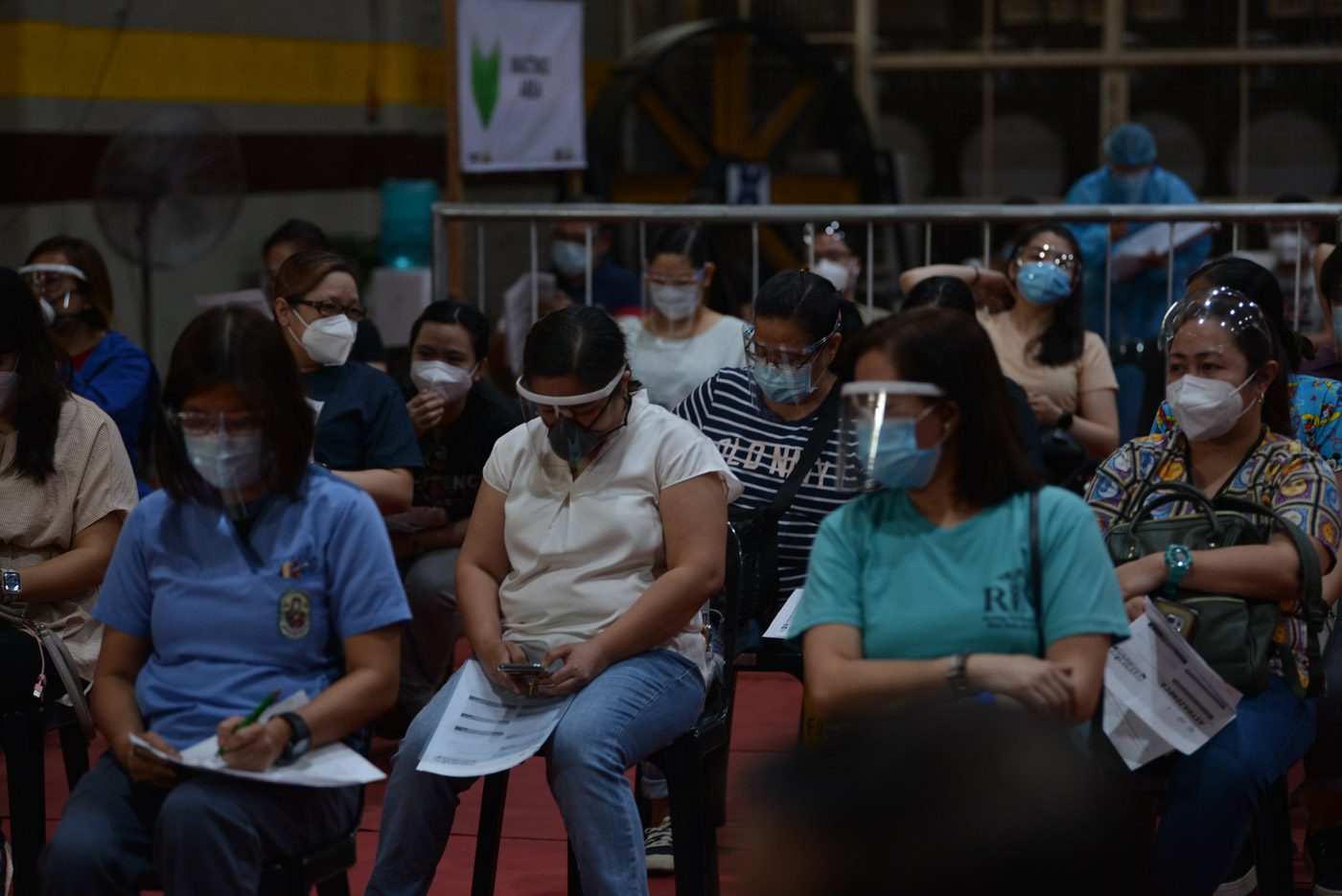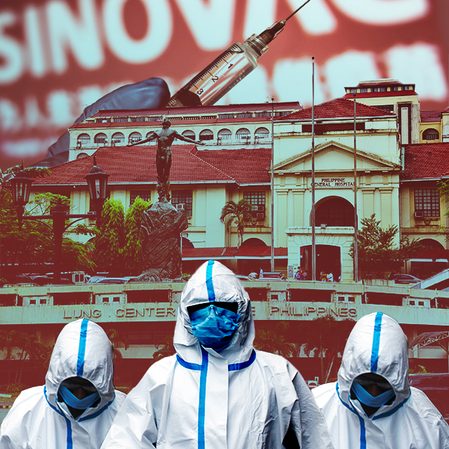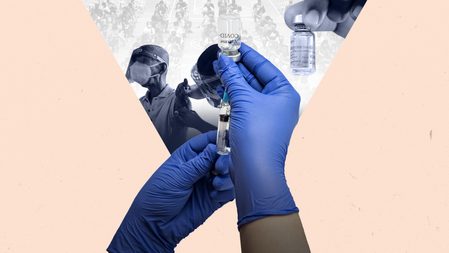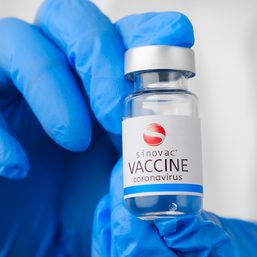SUMMARY
This is AI generated summarization, which may have errors. For context, always refer to the full article.

Facing growing pressure to speed up vaccinations in the Philippines, vaccine czar Carlito Galvez Jr remained confident the government could meet its target of vaccinating 70% of the population, saying the bulk of the country’s supply of COVID-19 shots will start arriving in April.
For Galvez and the Duterte government’s pandemic task force, a schedule of expected COVID-19 vaccine deliveries is crucial if they are to hold up their promise to achieve herd immunity in the country by the end of 2021.
Adding to the urgency of vaccinations, the Philippines – one of the countries hardest hit by the pandemic in Southeast Asia – is once again experiencing a deadly spike in infections, with daily cases reported shattering records over a year into the outbreak.
In 2021, Galvez asserted the Philippines would gain access to at least 140 million vaccines, including those purchased by the government from vaccine manufacturers and drug firms like AstraZeneca, Novavax, Moderna, Sinovac, Johnson and Johnson (Janssen Pharmaceutica), and the Gamaleya Research Institute.
Apart from this, the Philippines was also expecting more vaccines from the COVAX global facility led by the World Health Organization.
Which vaccines have arrived and when can you expect others to be delivered? (Updated as of December 13, 2021)
1st Quarter
Delivered:
- February 28 – 600,000 Sinovac doses donated by China
- March 4 – 487,200 AstraZeneca doses from COVAX
- March 7 – 38,400 AstraZeneca doses from COVAX
- March 24 – 400,000 Sinovac doses donated by China
- March 29 – 1 million Sinovac doses purchased by government
Announced but not delivered:
- March 24 to 26 – 979,200 AstraZeneca doses from COVAX
On Monday, April 5, World Health Organization Representative Dr Rabindra Abeyasinghe said expected deliveries from COVAX will be delayed due to a shortage of vaccines globally. Vaccine czar Carlito Galvez Jr earlier said the WHO had only given an indicative period for the delivery of more vaccines from the COVAX facility and had yet to give a specific date of arrival.
Like the Philippines, vaccine deliveries had been delayed for other Asian countries, including Vietnam, Indonesia, and South Korea. India, the world’s biggest vaccine maker, had put a temporary hold on exports of AstraZeneca’s vaccine being manufactured by the Serum Institute of India (SII), as officials focus on meeting rising domestic demand.
2nd Quarter
April
Delivered:
Announced but not delivered:
- April 28 – 18,000 Gamaleya doses (initial delivery to be used for practice in handling Sputnik V vaccine)
- End-April – 480,000 Gamaleya doses
- End-April to early-May – 195,000 Pfizer doses
- AstraZeneca doses from COVAX
Hours before the expected arrival of the shipment on Wednesday, April 28, Malacañang announced that the delivery of the Philippines’ first batch of Sputnik V COVID-19 vaccines from Russia was postponed due to “logistical challenges.” An initial delivery of 15,000 doses was expected to arrive in Metro Manila at around 10:45 pm on Wednesday, via a Qatar Airways plane from Doha, Qatar.
The delivery is now expected to arrive in May instead.
May
Delivered:
- May 1 – 15,000 Sputnik V doses (component 1)
- May 7 – 1.5 million Sinovac doses
- May 8 – 2,030,400 AstraZeneca doses from COVAX
- May 10 – 193,050 Pfizer doses from COVAX
- May 12 – 15,000 Sputnik V doses (component 2)
- May 20 – 500,000 Sinovac doses
- May 30 – 50,000 Sputnik V doses
Announced but not delivered:
- 2 million Gamaleya doses
- 2.1 million Pfizer doses from COVAX
In a briefing on May 14, Galvez said the Philippines was now expecting to receive up to 2.2 million doses of Pfizer’s vaccine in May, doubling the initial 1.1 million doses first announced to arrive within the month. Galvez said this became possible after COVAX committed to advance the delivery of 1.1 million doses scheduled to arrive in June.
Weeks later on May 26, Galvez said during a televised briefing that the 2 million Pfizer vaccines expected in May from COVAX would be delivered in June instead.
Galvez did not provide a reason for the delay, only saying that there had been a “slip” in total vaccine deliveries expected for the month. “The good thing here is these vaccines aren’t lost, it was just moved to June 7 to 11,” he said.
Aside from supplies of Pfizer’s vaccine from COVAX, volumes of the Sputnik V vaccine have not yet arrived in the country.
June
Delivered:
- June 6 – 1 million Sinovac doses
- June 10 – 1 million Sinovac doses
- June 10 – 2.28 million Pfizer doses from COVAX
- June 11 – 100,000 Sputnik V doses
- June 17 – 1.5 million Sinovac doses
- June 24 – 2 million Sinovac doses
- June 27 – 249,600 Moderna doses
- June 28 – 1 million Sinovac doses
Announced but not delivered:
- 1.9 million Gamaleya doses
- 2 million AstraZeneca doses from COVAX (third week of June)
On May 28, Philippine Ambassador to the US Jose Manuel “Babe” Romualdez said the Philippines will be among countries that will receive donated vaccines from the United States’ surplus supply of shots.
US President Joe Biden earlier pledged to have some 80 million vaccines delivered overseas by the end of June as part of a strategy to respond to the coronavirus pandemic. This included 60 million AstraZeneca vaccines that have not received emergency approval in the US, as well as 20 million more doses of Moderna, Pfizer, and Johnson & Johnson vaccines from the country’s stockpile.
On June 22, Romualdez said the Philippines would receive 800,000 to 1 million doses of either AstraZeneca or Moderna vaccines donated by the US.
The Philippines also saw a delay in the delivery of 50,000 doses of Sputnik V’s Component II vaccines in June. Galvez, citing the Russian Direct Investment Fund, said this was “due to ongoing upgrades and latest developments on the vaccine.” A new delivery date has yet to be announced.
As a result, second doses for those who received their first Sputnik V shot will be pushed back. But health officials said the same level of efficacy can still be achieved even if second shots are taken later than scheduled. The situation was likened to delaying shots for individuals due to illness or medical conditions
All in all, Galvez said the Philippines expects to receive about 10,158,000 vaccine doses in June.
3rd Quarter
July
Delivered:
- July 8 – 1.1 million Japan-donated AstraZeneca doses
- July 9 – 170,000 Sputnik V doses
- July 9 – 2 million AstraZeneca doses from COVAX
- July 14 – 1 million Sinovac doses
- July 15 – 250,800 Moderna doses
- July 16 – 1.15 million AstraZeneca doses
- July 16 – 1.6 million US-donated Johnson & Johnson doses
- July 17 – 1.6 million US-donated Johnson & Johnson doses
- July 17 – 1.5 million Sinovac doses
- July 21 – 562,770 Pfizer doses
- July 22 – 1.5 million Sinovac doses
- July 23 – 1 million Sinovac doses
- July 26 – 375,570 Pfizer doses
- July 29 – 1.5 million Sinovac doses
- July 30 – 1 million Sinovac doses
On July 8, Galvez said Sinovac deliveries expected for the first week of July had been pushed back since the company delivered 2 million doses in advance in June. The Philippines received 6.5 million doses from Sinovac in June, more than the expected 4.5 million doses.
The arrival of Sputnik V doses on July 9 also comes after an initial delay in shipment due to “logistical issues.”
August
Delivered:
- August 2 – 415,040 UK-donated AstraZeneca doses
- August 3 – 3 million US-donated Moderna doses
- August 5 – 1 million Sinovac doses
- August 8 – 326,400 Moderna doses
- August 11 – 813,150 Pfizer doses
- August 11 – 100,000 UAE-donated Sinopharm doses
- August 12 – 2 million Sinovac doses
- August 13 – 575,800 AstraZeneca doses
- August 13 – 15,000 Sputnik V doses (Component II)
- August 15 – 469,200 Moderna doses
- August 18 – 365,040 Pfizer doses
- August 19 – 3 million Sinovac doses
- August 20 – 582,500 AstraZeneca doses
- August 20 – 739,200 China-donated Sinopharm doses
- August 21 – 1 milion Sinovac doses
- August 21 – 260,800 China-donated Sinopharm doses
- August 25 – 362,700 Pfizer doses
- August 31 – 15,000 Sputnik V doses
- August 31 – 3 million Sinovac doses
Announced but not delivered:
- COVAX vaccines – 3 million doses
- Pfizer – 363,150 doses
- Moderna – 1,804,400 million doses
On August 3, DOH Undersecretary Myrna Cabotaje said the government is expecting to receive some 22.7 million vaccine doses within the month. This includes an additional 1.6 million doses of Sinovac’s vaccine the Philippine government is negotiating for purchase to boost vaccination efforts as the country seeks to contain the more contagious Delta variant.
On August 13, another 575,800 AstraZeneca doses purchased by the private sector arrived in the Philippines, though this was short of the 1.17 million doses expected to arrive that week. Galvez later said on August 17 that another 594,200 doses were expected to arrive within the month.
Presidential Spokesperson Harry Roque announced on August 19 that 739,200 Sinopharm doses donated by China were scheduled to arrive in the Philippines on August 20. A second delivery was scheduled for August 21, completing 1 million doses. This came later than the previous schedule of August 10.
September
Delivered:
- September 1 – 703,170 Pfizer doses
- September 2 – 188,370 Pfizer doses
- September 10 – 502,000 AstraZeneca doses
- September 10 – 1.5 million Sinovac doses
- September 13 – 2 million Sinovac doses
- September 15 – 753,480 Pfizer doses
- September 17 – 661,200 AstraZeneca doses
- September 18 – 961,000 Moderna doses
- September 18 – 190,000 Sputnik V doses
- September 19 – 3 million Sinovac doses
- September 19 – 2 million US donated Pfizer doses
- September 20 – 561,000 US donated Pfizer doses
- September 22 – 1 million Pfizer doses
- September 24 – 728,910 Pfizer doses
- September 26 – 3 million Sinovac doses
- September 29 – 391,950 Pfizer doses
- September 30 – 1.23 million Moderna doses
Announced but not delivered:
- Moderna – 3.4 million doses
- Pfizer – 1.8 million doses
- Sputnik V Light – 1 million doses
On September 8, Finance Secretary Carlos Dominguez III said that the government wants to receive at least 9 million doses per week to reach its target of inoculating at least 70 million Filipinos by the end of the year. So far, actual deliveries have yet to meet this.
In the first week of September, deliveries were short by some 6 million as the Philippines got about 3 million doses only. This target was finally met in the third week of September, when 9.5 million doses arrived – the largest weekly shipment to date.
The delayed Moderna shipments initially announced eventually arrived in the Philippines in subsequent deliveries within September and later in October.
4th Quarter
October
Delivered:
- October 1 – 883,350 US-donated Pfizer doses
- October 2 – 2.5 million Sinovac doses
- October 2 – 889,200 Pfizer doses
- October 3 – 1.8 million Pfizer doses
- October 6 – 3 million Pfizer doses
- October 7 – 1,003,860 Pfizer doses
- October 8 – 661,100 AstraZeneca doses
- October 8 – 2.132 million Moderna doses
- October 9 – 1.3 million Moderna doses
- October 10 – 900,000 US-donated Pfizer doses
- October 11 – 924,300 US-donated Pfizer doses
- October 11 – 272,610 Pfizer doses
- October 14 – 1.015 million Pfizer doses
- October 15 – 844,800 Germany-donated AstraZeneca doses
- October 15 – 1.068 million Pfizer doses
- October 16 – 720,000 Sputnik V doses
- October 16 – 207,090 Pfizer doses
- October 20 – 2,000 Brunei-donated AstraZeneca doses
- October 21 – 1.014 million Pfizer doses
- October 21 – 400,000 Sputnik V doses
- October 22 – 1.016 million Pfizer doses
- October 22 – 698,600 AstraZeneca doses
- October 24 – 3 million Sinovac doses
- October 28 – 976,950 Pfizer doses
- October 28 – 896,000 Japan-donated AstraZeneca doses
- October 29 – 973,440 Pfizer doses
- October 30 – 1,065,600 Japan-donated AstraZeneca
- October 30 – 1,546,200 AstraZeneca doses
- October 31 – 2,098,980 US-donated Pfizer dose
Expected:
- COVAX vaccines (Pfizer) – 3 million doses
- Sinovac – 10 million doses
- Pfizer – 10 million doses
- Moderna – 5 million doses
- Sputnik V Light – 1 million doses
- AstraZeneca – 1 million doses
- Donation – 1.5 million doses
With more vaccine doses arriving, the Philippines opened its vaccination drive to the general adult population on October 7. On October 15, it also started vaccination for minors in Metro Manila who are 12 to 17 years old and have comorbidities. Other areas in the country are expected to follow suit once they have vaccinated at least 50% of their elderly population, based on the DOH’s directive.
On October 14, China announced it would donate 1 million more Sinovac vaccines, bringing the total number of doses shared with the country to about 3 million. Japan on October 15 also announced it would donate nearly 2 million AstraZeneca doses, pushing the total number of doses given to the Philippines to over 3 million.
The US also donated over 3 million more Pfizer doses.
The month closed with the Philippines receiving over 34 million doses, its largest shipment in a month to date.
November
Delivered:
- November 2 – 2,700,000
- November 5 – 900,000 Pfizer doses
- November 6 – 866,970 Pfizer doses
- November 8 – 2,805,000 Sputnik V doses
- November 9 – 793,900 Germany-donated AstraZeneca doses
- November 10 – 866,970 Pfizer doses
- November 10 – 3 million Sinovac doses
- November 11 – 3 million Sinovac doses
- November 11 – 866,970 Pfizer doses
- November 13 – 1,279,000 Moderna doses
- November 15 – 301,860 US-donated Pfizer doses
- November 16 – 1,353,800 Moderna doses
- November 17 – 3,530,400 Sinovac doses
- November 18 – 609,570 Pfizer doses
- November 19 – 5,000 Russia-donated Sputnik Light doses
- November 19 – 2,805,000 Sputnik V doses
- November 19 – 1,306,000 Moderna doses
- November 23 – 682,360 Moderna doses
- November 24 – 700,000 Australia-donated AstraZeneca doses
- November 25 – 3.1 million UK- donated AstraZeneca doses
- November 25 – 1,017,900 Pfizer doses
- November 26 – 288,000 UK-donated AstraZeneca doses
- November 26 – 201,240 Pfizer doses
- November 27 – 1,746,160 UK-donated AstraZeneca doses
- November 28 – 547,100 Poland-donated AstraZeneca doses
- November 30 – 539,430 South Korea-donated AstraZeneca doses
As vaccines continued to arrive in the country, the government administered its highest number of jabs in a day on November 12, when over 1.2 million doses were given. Health and pandemic officials announced a three-day inoculation drive will also be held from November 30 to December, which aimed to cover at least 9 million Filipinos through a family-centered approach to vaccination.
On November 17, Sinovac completed the delivery of 51 million doses purchased by the Philippines in 2021, after over 3.5 million doses landed in the country. Along with donations, the number of doses delivered so far was about 54 million, while China committed to donate 2 million more Sinovac shots. The vaccine makes up about 40% of supplies in the country.
On November 19, Russia also completed the delivery of 10 million Sputnik V doses purchased by the Philippine government for the year, following the arrival of over 2.8 million doses.
The US, Russia, Germany, Poland, South Korea, and United Kingdom likewise continued to share vaccines with the Philippines.
December
Delivered:
- December 1 – 1,632,900 France-donated AstraZeneca doses
- December 1 – 1,082,250 Pfizer doses
- December 2 – 1,082,250 Pfizer doses
- December 6 – 1,497,200 Moderna doses
- December 6 – 1,085,760 Pfizer doses
- December 8 – 1,082,250 Pfizer doses
- December 9 – 255,200 AstraZeneca doses
- December 9 – 1,017,900 Pfizer doses
- December 10 – 698,600 AstraZeneca doses
- December 10 – 2,948,000 Moderna doses
- December 14 – 1,058,400 Spain-donated Moderna doses
- December 14 – 453,600 France-donated Moderna doses
- December 14 – 945,600 Netherlands-donated J&J doses
- December 14 – 2 million China-donated Sinovac doses
- December 14 – 266,400 Austria-donated J&J doses
- December 14 – 1,512,000 Sweden-donated J&J doses
- December 14 -2,011,200 Netherlands-donated J&J doses
- December 15 – 214,500 UK-donated AstraZeneca doses
- December 15 -856,800 Germany-donated Moderna doses
- December 15 – 3,055,200 Netherlands-donated J&J doses
- December 15 – 1,187,550 Pfizer doses
- December 15 – 2,249,400 AstraZeneca doses
- December 15 – 2,840,100 Germany-donated Moderna doses
- December 16 – 526,500 Pfizer doses
- December 17 – 1,020,500 Germany-donated Moderna doses
- December 17 – 940,800 Germany-donated Moderna doses
- December 17 – 1,164,150 Pfizer doses
- December 18 – 811,980 France-donated Pfizer doses
- December 19 – 1,062,100 Germany-donated Moderna doses
- December 19 – 663,400 AstraZeneca doses
- December 19 – 535,600 Germany-donated Moderna doses
- December 20 – 1,775,955 Pfizer doses
- December 20 – 976,950 Pfizer doses
- December 21 – 1,623,960 US-donated Pfizer doses
- December 21 – 1,697,000 France-donated AstraZeneca doses
- December 21 – 500,000 Argentina-donated AstraZeneca doses
- December 21 – 1,358,600 Moderna doses
- December 22 – 810,810 France-donated Pfizer doses
- December 23 – 1,543,230 Pfizer doses
- December 23 – 1,531,000 Germany-donated Pfizer doses
- December 23 – 1,187,550 Pfizer doses
- December 24 – 1,405,170 Pfizer doses
- December 26 – 1,957,000 AstraZeneca doses
- December 27 – 587,800 Germany-donated Moderna doses
- December 27 – 1,187,500 Pfizer doses
- December 28 – 2,005,300 AstraZeneca doses
- December 28 – 367,380 Pfizer doses
- December 29 – 1,981,500 AstraZeneca doses
- December 29 – 1,230,800 Moderna doses
- December 30 – 609,570 Pfizer doses
Expected:
- Pfizer – 17 million doses
- Moderna – 8 million doses
- AstraZeneca – 10 million doses
- COVAX – 25 million doses
- Donations – 7.3 million doses
On December 7, NTF Deputy Chief Implementer Vince Dizon said the Philippines was expecting to receive 67.3 million vaccine doses within the month.
The Philippines capped 2021 by receiving over 210 million COVID-19 vaccine doses – nearly double the number of vaccines it ordered for the year. Donations from COVAX and other countries added at least 70 million doses to the country’s stockpile.
Why it matters
Suffering one of the worst outbreaks in the region, the Philippines is expected to be one of the last to recover from the pandemic in Southeast Asia. The rollout of vaccines has been listed as one way to help revive the country’s economy which has suffered its worst drop since the end of World War II.
Beset by initial delays in paperwork and negotiations, the Philippines had also been the last country in Southeast Asia to start receiving COVID-19 vaccines. It was among the last in the region to launch its mass vaccine program on March 1, 2021.
Rollout targets
As soon as the bulk of vaccines start arriving in the Philippines by the second quarter, the government’s pandemic task force targeted to inoculate about 500,000 to 1 million per week from April to May.
From June to July, their target jumped to 1 to 2 million vaccinations weekly. After that, targets were pegged to about 3 to 5 million vaccinations per week.
In terms of priority sectors, a group of medical experts advising the government on its vaccination program said health workers should be the first to receive vaccines, followed by senior citizens, people with comorbidities, indigent populations, and other uniformed and frontline personnel.
In October 2021, the Philippine government shifted its vaccination targets upwards to reach at least 90% of the country’s population, after the highly transmissible Delta variant increased herd immunity thresholds for the disease.
Under initial targets, health officials were aiming to vaccinate about 77 million Filipinos to reach a goal of 70% of the population vaccinated. With targets now raised, vaccinating 90% of the country’s population would include inoculating adolescents below 18 years old since all eligible adult Filipinos are already factored in the 70% goal.
The Philippines has cleared both Pfizer and Moderna’s shot for emergency use among adolescents at least 12 years of age, but health experts said that with the current scarcity of doses in the country, vulnerable adult populations are still the priority in the government’s vaccine drive.
In early November, the country started rolling out vaccines to minors aged 12 to 17 – first, among adolescents with co-morbidities, followed by the rest of the eligible pediatric population.
On November 17, the Philippines also started administering booster doses to health workers. Senior citizens were later allowed to get boosted on November 22, while immunocompromised individuals were cleared to receive a third dose.
Later on December 2, the health department endorsed COVID-19 booster for all adults, saying vaccine supply was no longer an issue in the country.
Nine months since the start of the government’s vaccine program, 49% of the country’s population have received the first of two doses of a vaccine. Those who have received both doses represent about 36% of the population.
– Rappler.com
Read Rappler’s series of guides on the Duterte government’s vaccine program below:
- Your guide to COVID-19 vaccination for seniors, persons with comorbidities
- A guide to getting vaccinated as an economic frontliner
- Which Metro Manila LGUs allow walk-ins for A4 vaccinations?
- LIST: What to bring for your COVID-19 vaccination
Read Rappler’s series of explainers on the Duterte government’s vaccine program below:
- TRACKER: The Philippines’ COVID-19 vaccine distribution
- TIMELINE: The Philippines’ 2021 COVID-19 vaccine plan
- EXPLAINER: What to expect once COVID-19 vaccines arrive in the Philippines
- EXPLAINER: How COVID-19 vaccines will get from warehouses to you
- Securing vaccine deals: A checklist for local governments
- How FDA grants emergency approval for COVID-19 vaccines, meds
- PH to prioritize high-risk areas, sectors for COVID-19 vaccine rollout
- Gov’t releases new vaccine priority list, includes persons with comorbidities
- MAP: Which countries have started their COVID-19 vaccination program?
- LIST: Local governments’ plans, deals, and budget for COVID-19 vaccines
- FAST FACTS: Prioritized groups, guidelines for COVID-19 vaccination
- TRACKER: Which COVID-19 vaccines are being eyed by the Philippines?
- Meet the 5 experts’ groups advising PH’s COVID-19 vaccine program
- IATF adds more sectors eligible for COVID-19 vaccine as economic frontliners
Add a comment
How does this make you feel?



![[Rappler’s Best] US does propaganda? Of course.](https://www.rappler.com/tachyon/2024/06/US-does-propaganda-Of-course-june-17-2024.jpg?resize=257%2C257&crop=236px%2C0px%2C720px%2C720px)



There are no comments yet. Add your comment to start the conversation.